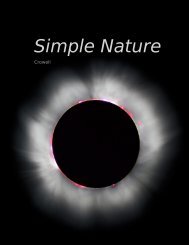Chapter 1 Conservation of Mass - Light and Matter
Chapter 1 Conservation of Mass - Light and Matter
Chapter 1 Conservation of Mass - Light and Matter
Create successful ePaper yourself
Turn your PDF publications into a flip-book with our unique Google optimized e-Paper software.
A car drives over a cliff.<br />
90 <strong>Chapter</strong> 2 <strong>Conservation</strong> <strong>of</strong> Energy<br />
new frame <strong>of</strong> reference, a change from zero velocity to −2v, which<br />
would violate conservation <strong>of</strong> energy. In other words, the physically<br />
possible motion conserves energy in all frames <strong>of</strong> reference, but the<br />
unphysical motion only conserves energy in one special frame <strong>of</strong><br />
reference.<br />
For our second example, we consider a car driving <strong>of</strong>f the edge<br />
<strong>of</strong> a cliff (r). For simplicity, we assume that air friction is negligible,<br />
so only kinetic <strong>and</strong> gravitational energy are involved. Does the car<br />
follow trajectory 1, familiar from Road Runner cartoons, trajectory<br />
2, a parabola, or 3, a diagonal line? All three could be consistent<br />
with conservation <strong>of</strong> energy, in the ground’s frame <strong>of</strong> reference. For<br />
instance, the car would have constant gravitational energy along<br />
the initial horizontal segment <strong>of</strong> trajectory 1, so during that time<br />
it would have to maintain constant kinetic energy as well. Only a<br />
parabola, however, is consistent with conservation <strong>of</strong> energy combined<br />
with Galilean relativity. Consider the frame <strong>of</strong> reference that<br />
is moving horizontally at the same speed as that with which the car<br />
went over the edge. In this frame <strong>of</strong> reference, the cliff slides out<br />
from under the initially motionless car. The car can’t just hover<br />
for a while, so trajectory 1 is out. Repeating the same math as in<br />
example 8 on p. 83, we have<br />
x ∗ = 0 , y ∗ = 1<br />
2 gt2<br />
in this frame <strong>of</strong> reference, where the stars indicate coordinates measured<br />
in the moving frame <strong>of</strong> reference. These coordinates are related<br />
to the ground-fixed coordinates (x, y) by the equations<br />
x = x ∗ + vt <strong>and</strong> y = y ∗<br />
where v is the velocity <strong>of</strong> one frame with respect to the other. We<br />
therefore have<br />
x = vt , y = 1<br />
2 gt2<br />
in our original frame <strong>of</strong> reference. Eliminating t, we can see that<br />
this has the form <strong>of</strong> a parabola:<br />
y = g<br />
x2<br />
2v2 self-check A<br />
What would the car’s motion be like in the * frame <strong>of</strong> reference if it<br />
followed trajectory 3? ⊲ Answer, p. 909<br />
.<br />
,<br />
,














